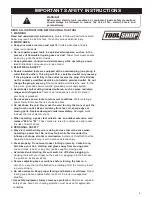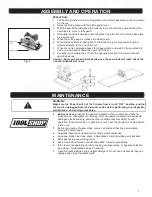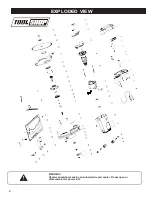
5. TOOL USE AND CARE
a.
Use clamps or other practical ways to secure and support the workpiece
to a stable platform.
Holding the work by hand or against your body is
unstable and may lead to loss of control.
b.
Do not force tool. Use the correct tools for your application.
The correct
tools will do the job better and safer at the rate for which it is designed.
c.
Do not use tools if switch does not turn it on or off.
Any tool that can not
be controlled with the switch is dangerous and must be repaired.
d.
Disconnect the plug from the power source before making any
adjustments, changing accessories or storing the tool.
Such preventive
safety measures reduce the risk of starting the tools accidentally.
e.
Store idle tools out of reach of children and other untrained persons.
Tools are dangerous in the hands of untrained users.
f.
Maintain tools with care.
Keep cutting tools sharp and clean. Properly
maintained tools with sharp cutting edges are less likely to bind and are easier
to control.
g.
Check for misalignment or binding of moving parts, breakage of parts
and any other conditions that may affect the tools operation.
If damaged,
have the tools serviced before using. Many accidents are caused by poorly
maintained tools.
h.
Use only accessories that are recommended by the manufacturer for your
model.
Accessories that may be suitable for one tool, may become hazardous
when used on another tool.
6. SERVICE
a.
Tool service must be performed only by qualified repair personnel.
Service or maintenance performed by unqualified personnel could result in a
risk of injury.
b.
When servicing a tool, use only identical replacement parts.
Follow
instructions in the maintenance section of the manual. Use of unauthorized
parts or failure to follow maintenance instructions may create a risk of electric
shock or injury.
7. Hold tool by insulated gripping surfaces when performing an operation
where the cutting tool may contact hidden wiring or its owncord.
Contact with a “live” wire will make exposed metal parts of the tool “live” and
shock the operator.
8. Ensure
the extension cord you use is of sufficient gauge for its length.
Amps from Tool Nameplate
25’ length
Recommended Minimum Wire Gauge for Extension
50’ length
75’ length
Cords
100’ length
150’ length
200’ length
0-5 amps
16 ga.
16 ga.
16 ga.
14 ga.
12 ga.
12 ga.
5.1-8 amps
16 ga.
16 ga.
14 ga.
12 ga.
10 ga.
Do Not Use
8.1-12 amps
14 ga.
14 ga.
12 ga.
10 ga.
Do Not Use
Do Not Use
12.1-15 amps
12 ga.
12 ga.
10 ga.
10 ga.
Do Not Use
Do Not Use
15.1-20 amps
10 ga.
10 ga.
10 ga.
Do Not Use
Do Not Use
Do Not Use
9. STAY ALERT.
Watch what you are doing & use common sense. Don’t operate any tool when
tired.
3
IMPORTANT SAFETY INSTRUCTIONS




























